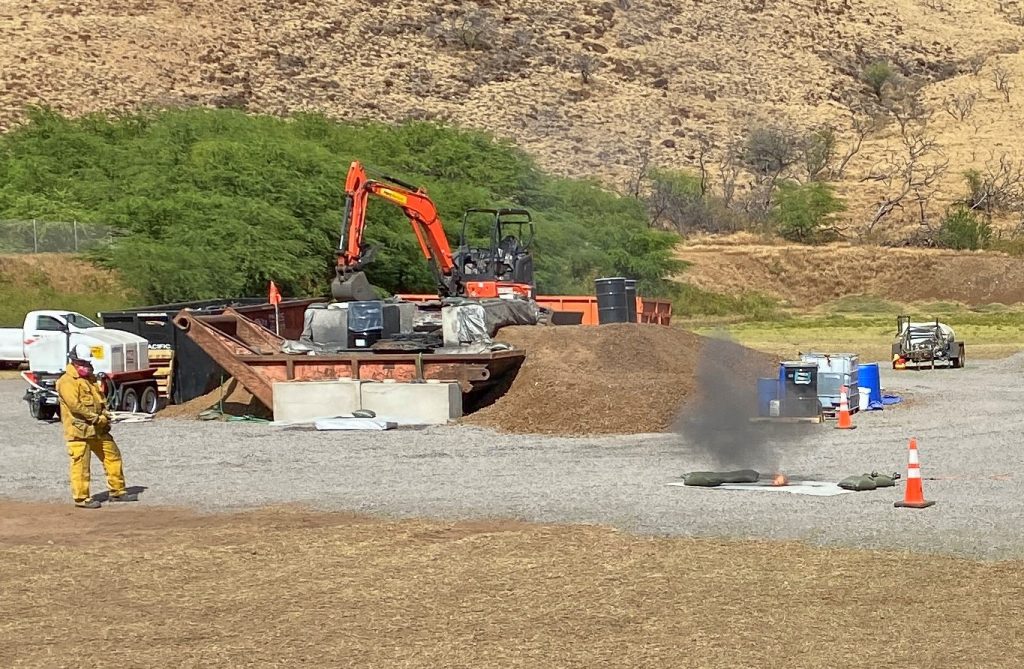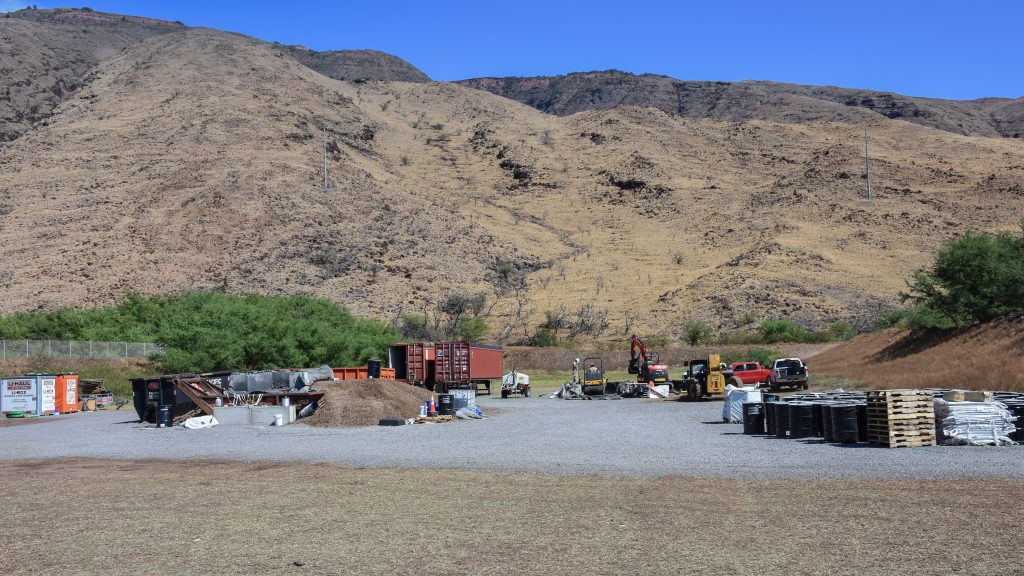EPA processing hundreds of thousands of lithium-ion batteries from Maui fires for recycling in Nevada

In a desolate area of Olowalu, at a temporary hazardous materials staging site set up by the US Environmental Protection Agency, workers wearing flame retardant clothing and respirators have been crushing hundreds of thousands of lithium-ion batteries with a drumroller.
The batteries have come from about 100 electric or hybrid vehicles and close to 300 battery energy storage systems for solar power that were burned or damaged in the Lahaina and Kula fires of Aug. 8.
The crushing is the final stage of a long process to identify and collect the potentially dangerous batteries from the burn sites, and de-energize them for safe transport via ship.
“No ocean shipping company would take the battery components until they had been de-energized,” said Chemist Cory Koger, emergency management specialist with the US Army Corps of Engineers. “That’s because there’s potential that if it goes catastrophic, and batteries catch on fire and they catch other batteries on fire, that it could sink a ship.”
Once on the mainland, the batteries are transported by truck to their final destination at Redwood Materials in northern Nevada. There, the batteries — which look like big AAs — will be recycled for rare metals that are expensive and hard to mine, with disposal of what’s left.

“I think they get over 90% recovery of the battery materials to remake lithium-ion batteries,” said Eric Nuchims, deputy incident commander for the EPA’s Maui Wildfire Response. “We’re not sure what we’re going to get with our batch, but that’s the industry standard.”
Already, at least two 40-foot container loads of the processed batteries have been shipped to Nevada.
In one battery energy storage system, which is called a BESS, there are about 1,000 lithium-ion batteries. In a Tesla electric vehicle, there are anywhere from 4,000 to 7,000 such batteries depending upon the model.
Tara Fitzgerald, incident commander of the EPA’s Maui Wildfire Response, said it’s the first time EPA has been “tasked by FEMA” with the responsibility of dealing with lithium-ion batteries during a disaster response.
Koger said this fire is unique because of the “sheer numbers” of electric vehicles and solar energy storage systems. “In the California fires, we didnʻt have these kinds of numbers,” he said.
The lithium-ion batteries have made the cleanup more complex. Last week at a community meeting at the Lahaina Civic Center, Fitzgerald said: “They remain extremely dangerous after they’ve been impacted by fire. Even if they mostly burn, they can result in a risk of fire, electric shock, overheating, or releasing toxic or explosive gases, so it’s been important for us to remove those.”
Lithium-ion batteries work through a chemical reaction that stores chemical energy before converting it to electrical energy. The reaction occurs when lithium ions release free electrons, and those electrons flow from the negatively-charged anode to the positively-charged cathode.
Nuchims explained that if lithium ion batteries still hold a charge, “they can go into a process of thermal runaway, which then propagates to other batteries. And then you get a fire that cannot be extinguished immediately with water.”
At the staging site, just four lithium-ion batteries produced a fire.

The removal of lithium-ion batteries is part of EPA’s Phase 1 work, during which crews also are removing acid batteries, household hazardous materials and large pieces of asbestos. FEMA has allotted the EPA $76.25 million for this work, which includes cultural monitors, applying soil stabilizer and monitoring the air quality.
Fitzgerald said at the community meeting “the end of our Phase 1 activities is in sight.”
On Monday, she said she expects all the residential parcels will be completed by early next week and the commercial properties completed by the end of November/early December. She said the processing of lithium-ion batteries and the application of the soil stabilizer also should be completed in December.
Vehicles usually are not handled during the hazardous material removal phase of disaster cleanups. For the Maui wildfires debris removal, most of the nearly 4,000 vehicles have standard gasoline and diesel systems and will be handled by the US Army Corps of Engineers in its second phase (main removal of debris).
“But in this case, since EPA was already processing such a large volume of the BESSes, it made sense for us to continue to work with electric vehicles as well,” Nuchims said.
An EPA team sat in a trailer at the staging site and developed all the ways they thought they could do the removal.
“We didn’t know how hard it was going to be,” Nuchims said.
While BESS units are fairly uniform, even with different manufacturers, electric vehicles are made substantially differently by different manufacturers, and located in different parts of the vehicle.
EPA crews used the National Fire Protection Association‘s emergency response guides for vehicles to help identify where the batteries and high-voltage wires are located in each model.
“Unfortunately the newest of the new vehicles aren’t on their website,” Nuchims said.
One of the first issues was simply to be able to identify the electric or hybrid vehicles among the thousands of burned or damaged vehicles. The fire was so hot that most VIN numbers and license plates were melted.
He said he couldn’t tell most electric vehicles from a regular vehicle just from the outside, and hybrids are even more difficult to pick out because they also have a gasoline engine.
“But we had a couple stars that were just car guys that got assigned to us,” Nichums said. “They were able to identify all these vehicles, even if they were completely burned, which most of them were.”
Once the electric and hybrid vehicles were identified, local electricians hired for the project determined if the batteries had an energy left in them and advised how to safely deal with them.

At first, the EPA team considered bringing back whole vehicles to process at the staging site, but it was determined the work of removing the batteries — which for some vehicles included cutting parts of the frame or flipping it over — could be done where the cars were found.
In a presentation EPA gave Bob Fenton, FEMA’s chief federal response coordinator for the Maui fires, there is a video also taken at the staging site that shows the teeth of an excavator bucket trying to peel away the outer housing of a BESS.
“It arcs and sparks,” Nuchims said. “That is why we have electricians to go with us. They check the vehicles and BESSes for voltage so the crews know what they are handling.”
If voltage is detected, personal protective equipment is upgraded to level B, which is a self-contained breathing apparatus to protect against the toxic vapors. These can include hydrofluoric gases that are very poisonous, highly irritating and corrosive — and can be fatal if inhaled, swallowed or come in contact with skin, according to Purdue University’s Environmental Health and Safety website.
There were no mishaps removing the batteries in the field, Nichums said.
At the staging site, if batteries still have a charge they are put in a trench box filled with a brine (saltwater) solution for 4 to 7 days to de-energize them before they are crushed.
Nuchims said “call outs” to deal with lithium ion batteries have become more frequent for the EPA. In February, he responded to a 3-Alarm fire of a large commercial building in Laguna Hills, Calif., that was burning out of control due to lithium-ion batteries used for electric bikes.
In August, there was the case of a Volvo electric truck running into a cargo train in Carson, Calif.
The collision caused the cells of the Volvo’s battery pack to ignite and explode. Because the cells do not require oxygen to burn, firefighters were having a difficult time putting it out, according to an Los Angeles TV station.
“It had six different battery packs,” Nuchims said. “They tried to move it three times and it reignited three times.”
Another challenge in Lahaina was the large number of unsafe structures. There are between 150 and 200 BESS units that have been identified but can’t be removed by EPA because they are located in places that are too dangerous to access, Nuchims said.
“A majority of those are commercial structures, similar to what you’ve see along Front Street,” he said.
These BESS units will be deferred to the US Army Corps of Engineers, which also is conducting its own Phase 1 hazardous material removal before its main debris removal.
Koger, with the Army Corps, said the same EPA protocols will be used for de-energizing the batteries. The difference is the Army Corps has a contractor that can take down any unsafe walls to allow access to them.
If the EPA site in Olowalu is still operating, the Army Corps will transport the batteries there for processing. But if the EPA is done with its site, the Army Corps will have them de-energized at its staging area for hazardous material, which is at a county-owned parking lot in Lahaina, Koger said.
There also may be more electric or hybrid vehicles to deal with, including the potential for some at parking structure of a condo that has been under water because its pump stopped working, Koger said.
The Army Corps contracted with Tacoma-based ACTenviro for its hazardous waste disposal. Except for the lithium-ion batteries, which also will go to Redwood Materials, Koger said the Army Corps has not yet determined where the hazardous material will be shipped, “but nothing is staying on the island.”
















